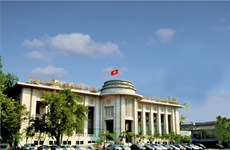Hanoi set for more modern shopping
The capital city of Hanoi plans to introduce nine more shopping and
trade-fair centres, according to the city's general plan on development
of commercial activities by 2020 and towards to 2030.
The capital city of Hanoi plans to introduce nine more shopping and
trade-fair centres, according to the city's general plan on development
of commercial activities by 2020 and towards to 2030.
The Hanoi Construction Department said under the plan, Hanoi will have one international trading centre in the Tay Ho Tay urban area, two international trade fair centres in the My Dinh commune, Tu Liem district and Dong Anh urban area and also five shopping centres in Gia Lam and Soc Son districts, Chuc Son Town and Hoa Lac and Phu Xuyen urban areas.
The city currently has 14 trading centres, accounting for 15 percent of the national total number. Those 14 are almost all located in inner districts of the capital.
In the draft of the development plan for commercial activities, Hanoi will develop a network for markets to improve the quality of current markets in the city.
The city will upgrade key markets with an area of more than 10,000sq.m each to be the central markets of the city. Other markets with an area between 500-10,000sq.m will also be developed as retail markets for farming products and fresh food.
Many supermarkets, food outlets and convenience stores will also be created from markets with a current area of 2,000sq.m or less. A number of wholesale markets for farming products will also be created as part of the plan.
Markets in rural areas will also be upgraded to create shopping hubs and promote commerce for local residents.
Hanoi also plans to build large wholesale markets for farming products and food with an area of 30ha each and develop centres for wholesale farming products to serve customers nation-wide with modern transaction services.
Deputy chairman of the People's Committee of Hanoi Vu Hong Khanh said the plan involves programmes and projects to help tackle specific issues regarding developing Hanoi as a large trading centre in the country and the region. The plan will be a foundation for developing suitable trading centres and markets in the city.
Hanoi has 411 markets with a number of limitations, such as unsuitable locations, outdated infrastructure, a lack of waste treatment systems and poor safety conditions.-VNA
The Hanoi Construction Department said under the plan, Hanoi will have one international trading centre in the Tay Ho Tay urban area, two international trade fair centres in the My Dinh commune, Tu Liem district and Dong Anh urban area and also five shopping centres in Gia Lam and Soc Son districts, Chuc Son Town and Hoa Lac and Phu Xuyen urban areas.
The city currently has 14 trading centres, accounting for 15 percent of the national total number. Those 14 are almost all located in inner districts of the capital.
In the draft of the development plan for commercial activities, Hanoi will develop a network for markets to improve the quality of current markets in the city.
The city will upgrade key markets with an area of more than 10,000sq.m each to be the central markets of the city. Other markets with an area between 500-10,000sq.m will also be developed as retail markets for farming products and fresh food.
Many supermarkets, food outlets and convenience stores will also be created from markets with a current area of 2,000sq.m or less. A number of wholesale markets for farming products will also be created as part of the plan.
Markets in rural areas will also be upgraded to create shopping hubs and promote commerce for local residents.
Hanoi also plans to build large wholesale markets for farming products and food with an area of 30ha each and develop centres for wholesale farming products to serve customers nation-wide with modern transaction services.
Deputy chairman of the People's Committee of Hanoi Vu Hong Khanh said the plan involves programmes and projects to help tackle specific issues regarding developing Hanoi as a large trading centre in the country and the region. The plan will be a foundation for developing suitable trading centres and markets in the city.
Hanoi has 411 markets with a number of limitations, such as unsuitable locations, outdated infrastructure, a lack of waste treatment systems and poor safety conditions.-VNA













